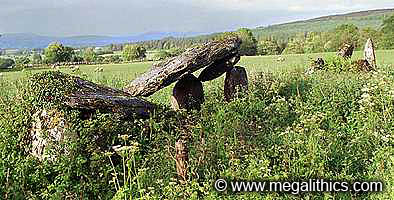
 |
Photo Gallery |
|
Panoramas |
||
Rock Art |
| H 37330 83180 (GPS 15min.) roof slab W. tomb. | Visited June 2002 |
The tombs at Ballyrenan stand behind a farm
about 200m along a side road, off the B84 between Drumquin and Newtownstewart.
The remains of three tombs exist today, and they were all originally set in a
now-vanished longcairn.
To the east is a single Portal Tomb, its capstone has gone, but the portals and
side slabs still stand, we thought there may have also been a backstone, but the
tomb was so overgrown we could not be sure. Between and just behind the portal
stones we found a tall sill stone, but the chamber interior itself was hidden in
the dense undergrowth.
To the west is a curious double Portal Tomb arrangement, the western tomb of the
pair was obviously built first, as the capstone of the middle tomb rests upon its
roof, making the tombs "semidetached". The western tomb looked to
be totally intact, although the west facing portal area was so deeply buried in
vegetation we could not make out anything of its structure. The other tomb's
portal faces east and has a lintel stone over the entrance below the roof slab,
a feature the western tomb is said to share. The eastern tomb of the pair has
side stones, and uses the rear of the western tomb as a back closure, we found a
small stone standing between the portal stones and wondered if this was a sill
stone, or perhaps a fragment of a full front closure stone.
A large slab sticks out horizontally from the northern side of the tombs,
it is wedged under the roofstone of the western tomb. If any great pressure is
put on this stone, it levers the roofstone upwards, and because the eastern
roofstone rests upon western, this stone moves upwards as well, putting the
structures of both tombs into disconcerting motion.
The roofstones of both of the western tombs are covered in cupmarks, a few of
these are very deep, but most are shallow, hidden in the moss and lichen growth
on the two stones.
We have seen cupmarks on the upper surfaces of roofstones at several other
Portal Tombs, and find their location curious. When you consider that the roof
slabs would have been buried beneath the covering cairn, the living would not be
able see them, they would also be invisible to anyone in the chamber, living or
dead. At several cairns, the kerbs have their decorated sides facing inwards
under the mound, and therefore invisible to observers, perhaps the
concealment of decoration on these monuments shares a common origin.
e -->